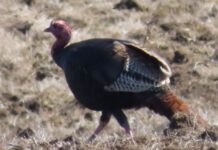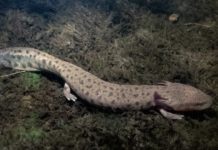

by Fred Schueler – Fragile Inheritance Natural History
This year’s Mudpuppy Nights in Oxford Mills got underway on Friday, 16 October, with the sighting of two of its iconic beasts. The limestone flats of the South Branch river below the Oxford Mills dam is the only place in Canada where you can wade among giant salamanders every Friday night through the winter. Mudpuppy Nights have been bringing people face to face with Mudpuppies in the wild since 1998, and while they were begun in part to inspire others to observe winter Mudpuppies elsewhere, no other site has been found where they can be routinely seen.
Mudpuppies, Necturus maculosus, are foot-long permanently aquatic Salamanders. They retain the gills and smooth skin of larvae as adults, and go undetected in many waterbodies because of their secretive habits. Mudpuppies are slow and cautious, though they can swim nearly as fast as a fish on occasion. In May females deposit 50-150 eggs on the underside of a flat rock. The female guards the eggs, and guards the larvae after they hatch.
In the 1980s herpetologists realized that Mudpuppies are active, and feed actively, all winter, because they can be caught in baited minnowtraps in the winter but not in the summer. Mudpuppies were long famous for having more DNA in each cell than just about any other animal, and this winter activity has shown that the abundant DNA provides Mudpuppies with the array of temperature-adjusted enzymes they require to operate in water from 0°C to 32°C. Mudpuppies are fairly common in the Ottawa River and its major tributaries, north to the Arctic Watershed, and the Canadian range extends through southern Quebec, Ontario, and Manitoba. The South Branch river below Oxford Mills supports one of the densest well-known populations.
On Friday, Amanda Bennett found and filmed two Mudpuppies, one mostly concealed in a crack in the bedrock, and one trying to swallow a frog, which escaped as the Mudpuppy retreated under a rock. Other species Amanda and Matt Keevil found on this first Mudpuppy Night included juvenile and tadpole Bull Frogs, the invasive hybrid Crayfish which have taken over the creek from the natives since 2012, Whirligig Beetles circling around among the plants and algae, and many small fish, which included juvenile Fallfish (Semotilus corporalis), Pumpkinseed Sunfish, Rock Bass, Largemouth Bass, Bluntnose Minnows, and many Banded Killifish. Plants included Beggersticks (Bidens), growing in ankle-deep Spirogyra algae (Water-silk) which cloted the flats during the spring and summer drought. There was also a patch of Common Duckweed, and a little Wild-rice, which has previously been seen on the flats only in the droughts of 2012 and 2018.
Mudpuppy Nights are every Friday evening at 20h00 from the first Friday after Thanksgiving until spring high water, at the parking lot beside the Oxford Mills dam. To let us know you’re coming, please contact us by phone at (613)299-3107, or e-mail bckcdb@istar.ca. There’s no registration fee, but donations are very much appreciated.
Mudpuppy Night results are reported weekly on the NatureList – https://groups.google.com/g/naturelist – and facebook – https://www.facebook.com/MudpuppyNight







To accommodate covid pandemic concerns, we’re limiting each Mudpuppy Night to one outside party at a time (in addition to Aleta & me and Amanda Bennett & Matt Keevil). If you’re going to want to come, contact Aleta at (613)299-3107 or to arrange a visit.